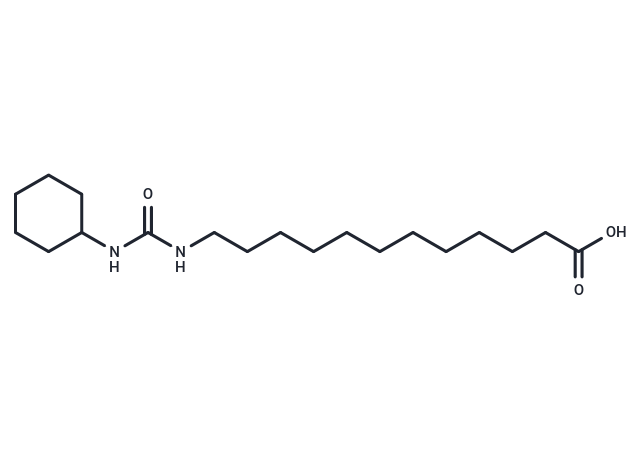Shopping Cart
- Remove All
 Your shopping cart is currently empty
Your shopping cart is currently empty

CUDA is an effective soluble cyclohydrolase inhibitor with IC50 of 11.1 nM and 112 nM for mouse sEH and human sEH, respectively. CUDA selectively increases the activity of peroxisome proliferator-activated receptor (PPAR) alpha. CUDA may be valuable for the study of cardiovascular diseases.

| Pack Size | Price | Availability | Quantity |
|---|---|---|---|
| 5 mg | $41 | In Stock | |
| 10 mg | $66 | In Stock | |
| 25 mg | $132 | In Stock | |
| 50 mg | $219 | In Stock | |
| 100 mg | $352 | In Stock |
| Description | CUDA is an effective soluble cyclohydrolase inhibitor with IC50 of 11.1 nM and 112 nM for mouse sEH and human sEH, respectively. CUDA selectively increases the activity of peroxisome proliferator-activated receptor (PPAR) alpha. CUDA may be valuable for the study of cardiovascular diseases. |
| Targets&IC50 | sEH (human):112 nM, sEH (mouse):11.1 nM |
| In vitro | CUDA (10 μM; 18 hours) induced a 6-fold and 3-fold increase in PPARalpha mRNA expression in COS-7 cells without altering PPARalpha protein levels. It competitively inhibits Wy-14643 (pirinixic acid) binding to the PPARalpha ligand binding domain, indicating its role as a PPARalpha ligand. |
| Molecular Weight | 340.5 |
| Formula | C19H36N2O3 |
| Cas No. | 479413-68-8 |
| Smiles | N(C(NCCCCCCCCCCCC(O)=O)=O)C1CCCCC1 |
| Relative Density. | 1.03 g/cm3 (Predicted) |
| Storage | Powder: -20°C for 3 years | In solvent: -80°C for 1 year | Shipping with blue ice. | ||||||||||||||||||||
| Solubility Information | DMSO: 3.41 mg/mL (10 mM), Sonication is recommended. | ||||||||||||||||||||
Solution Preparation Table | |||||||||||||||||||||
DMSO
| |||||||||||||||||||||

Copyright © 2015-2025 TargetMol Chemicals Inc. All Rights Reserved.